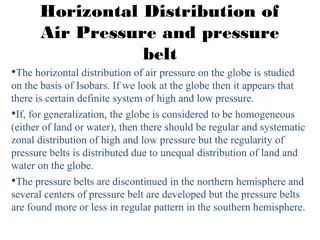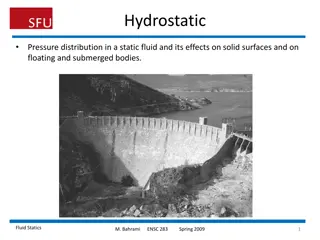Understanding Pressure in Liquids: Changes with Depth & Floating/Sinking
Learn about how liquid pressure changes with depth, why some objects float while others sink, and the effects of temperature on gas pressure. Explore the arrangements of particles in solids, liquids, and gases, and understand why dams have thick walls at the base. Enhance your knowledge of internal pressure in liquids and gases, and complete engaging tasks to solidify your understanding of these concepts.
Download Presentation

Please find below an Image/Link to download the presentation.
The content on the website is provided AS IS for your information and personal use only. It may not be sold, licensed, or shared on other websites without obtaining consent from the author. Download presentation by click this link. If you encounter any issues during the download, it is possible that the publisher has removed the file from their server.
E N D
Presentation Transcript
Pressure in Liquids Learning objectives: Describe how liquid pressure changes with depth Explain why some things float and some things sink Starter: Explain how an increase in temperature will affect the gas pressure inside a balloon.
Recap: Arrangement of particles in solids, liquids and gases Task: Watch the video and answer the following questions: 1. 2. Are you able to compress a solid? Explain your answers 3. Describe the arrangement of particles in a liquid. 4. Are you able to compress a liquid? Explain your answer. 5. Describe the arrangement of particles in a gas. 6. Are you able to compress a gas? Explain your answer. Describe the arrangement of particles in a solid.
Self-assessment: 1. Particles in a solid are held in a regular pattern, where they can vibrate in fixed positions. 2. You cannot compress a solid because the particles are so closely packed together. 3. The particles in a liquid are free to move and so can flow over each other. 4. You are not able to compress a liquid as the particles are so closely packed together. 5. Particles found in a gas can move around randomly at very high speeds. 6. Yes, you are able to compress a gas because the particles are so far apart from each other that you are able to squash them together to compress the gas.
Under Pressure Liquids and gases have their own internal pressure because of their weight. Think > Pair > Share: Why do you think dams have thick walls at the base?
Because there is a higher amount of water pressure at the bottom of the river than the top. This is because there are more particles pushing against the wall of the dam at this point. Task: Complete the following sentences: Pressure is the amount of force pushing on a certain area. The larger the force the bigger the The larger the force the bigger/smaller the pressure. pressure. The size of the pressure depends on the size of the force and the size of the area it is pushing on. The larger the area the bigger/smaller the pressure pressure. The larger the area the smaller the http://www.adweek.com/socialtimes/wp-content/uploads/sites/2/2012/03/shutterstock_90181546.jpg
Under Pressure If you look at the cross-section of a dam, you will notice that it is much thicker near the bottom than it is at the top. By the end of this activity you should be able to explain why. Task: Watch the observation and complete the worksheet questions in your books: https://www.youtube.com/w atch?v=K5g6P8-GmBg 1 Were the holes in each spout the same size? 2 When did the water come out of the bottom spout fastest? 4 During the experiment, describe what happened to the way that the water came out of the spouts? 4 The way that the water comes out of the spout depends on the pressure: the bigger the pressure in the water, the faster the water comes out. Which spout has the biggest pressure to push the water out? 5 Link your answer to question 5 to the design of a dam. Why are dams thicker at the bottom?
Self-assessment: 1 The holes in each spout were the same size 2 The water came out the bottom fastest when the water column was full with water, at the very beginning of the demonstration. 3 As water left the water column and was not replaced, the water level went down as more water left through the spouts. As this happened, the speed and force in which the water left the spouts decreased. 4 The spout at the bottom of the water column has the biggest pressure to push water out. 5 Dams needs to be thicker at the bottom as the bottom of the dam is exposed to increased water pressure as so the dam needs to have thick, strong walls to withstand this pressure keeping the water contained!
The arrows are drawn all around the fish to show pressure occurring from all directions. The different sized arrows show that the amount of pressure is not equal.
Task Pressure in the Pool 1. Draw the following diagram in your book 2. Can you draw four arrows on to show the directions in which the water exerts pressure on the boy
Self-assessment: Liquid pressure at the surface of the sea is lower. Liquid pressure at the bottom of the sea is higher. The liquid pressure underneath the boy creates upthrust, this is the force that will keep him afloat. This is because there are far more water molecules below the boy than there are above him, this produces the upthrust effect.
Plenary ~ Complete one of the following sentences in your book: Today I have learnt that One thing I must remember from today s lesson is I still don t understand . Before this lesson I already knew how to
Resources Resources























